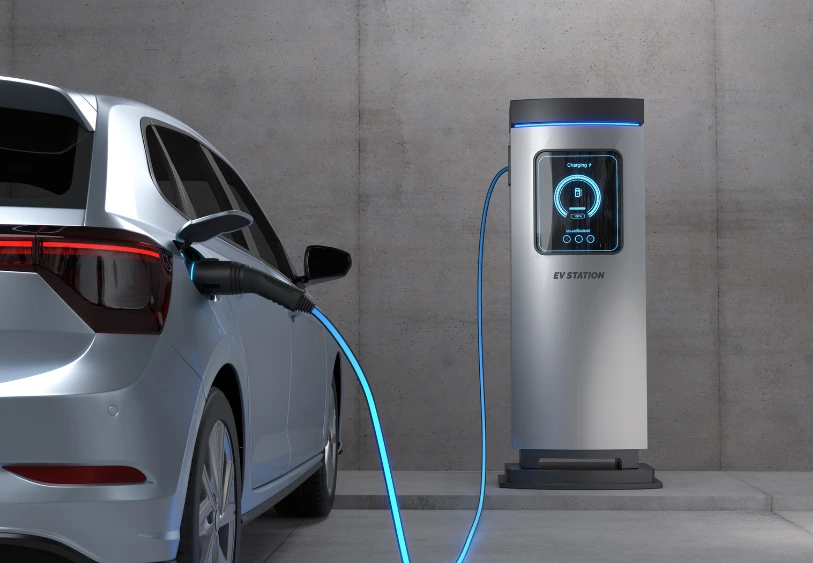 Date: July 02, 2025
Date: July 02, 2025
Electric Vehicles (EVs) are redefining the future of transport, particularly in the UAE, where innovation and sustainability meet. But with EVs comes the need to know how to charge them properly. Charging an EV is not just a matter of plugging it in; it’s about knowing the right time, place, method, and etiquette.
EV Charging - The Basics
Similar to the need to charge your phone or computer, your EV must be connected to a power source so that it can charge its battery. In contrast to gas stations, where there is fuel standardization, however, recharging EVs involves a bit more technicality.
There are various chargers, plugs, and power levels that charge at varying speeds. EVs run on lithium-ion batteries, and the charger accomplishes this by delivering energy from the grid to the vehicle battery through AC (alternating current) or DC (direct current).
Some of the key points to emphasize are
- Power Ratings: Chargers come in 2 kW to more than 300 kW capacities. The higher kW value translates to a quicker charge.
- Connector Types: All EVs come with a particular type of plug (CCS, CHAdeMO, Type 2), and the station needs to be compatible.
- Charging Stations: They differ in speed, availability, and cost.
Basic Terminologies in EV Charging
It is informative to know the general terms used in EV charging so that you can prepare yourself before you visit a charging station. These terminologies are generally used interchangeably, but are used to express different parts of the charging system.
- EV Chargers: A Physical hardware device to charge your car from an electricity source. This might be a wall box at home or a street rapid charger.
- Charging Stations: Locations where EV chargers are installed, including malls, parking areas, or fuel stations.
- Charging Points: Individual plug-in points or outlets where you plug in your EV yourself.
- Electric Vehicle Supply Equipment (EVSE): This is the complete electric system of gadgets, cables, and protective devices meant to supply electricity safely to your EV.
Charging Locations of EVs
Perhaps one of the greatest advantages of having an EV is having a power recharge at many locations, not necessarily gas stations like gasoline-powered vehicles. Depending on lifestyle and schedule, you can pick the most suitable charging location.
Common EV Charging Places are
- Home Charging: Best for overnight charging. The majority of owners have a wall box installed, which is quicker than using the standard plug socket. It's the most convenient and most affordable option.
- Workplace Charging: More employers provide EV charging facilities. Charging your battery at work is a fantastic way to cut down on your use of public charging.
- Public Charging: Provided in shopping malls, supermarkets, and public parking centers. These pods typically supply Level 2 or Level 3 charging for quicker top-ups.
- Fuel Stations: Most conventional fuel stations now have fast chargers, so you can grab a quick 20–30-minute fill-up on your break.
- Malls and Supermarkets: Perfect for shopping and topping up or picking up groceries. Some are complimentary or loyalty-card-based charging arrangements.
Charging Levels of EVs

All chargers are not the same. Charge levels are the rate of power transfer and your car's refueling rate.
The primary levels are
Level 1: Slow Charging
- Utilizes a standard domestic socket.
- Charging is extremely slow and may take as much as 12 hours to fully charge.
- Only suitable in emergencies or at night if nothing else can be found.
Level 2: Medium Charging
- Installed in-home wall boxes and public charging stations.
- Offers 7–22 kW of power and most often charges a car in 4–6 hours.
- Best used for daily driving.
Level 3: Fast Charging (DC)
- Found in highways and public stations.
- Offers 50–350 kW.
- Charges your battery to 80% in less than 30 minutes.
- Best used on long drives or when time is limited.
AC vs. DC Charging:
- AC (Alternating Current): Used in homes and offices. Reduced to a lower rate by the vehicle's onboard charger.
- DC (Direct Current): Used in fast charging stations. Supplies electricity to charge the battery quickly.
The EV Charging Curve
One of the key things many EV owners don’t initially know about is the charging curve, how fast your battery charges at different stages.
- EVs charge fastest between roughly 20% and 80%.
- Once your battery reaches 80%, charging slows significantly to protect the battery's lifespan.
- This is known as the “EV charging curve,” and it's why manufacturers often quote charge times from 20% to 80%, not 0% to 100%.
Prepare Your EV for Charging the Right Way

Little things before charging can save you time and make your battery last longer. Preparation is the secret to smart and efficient charging.
What to do before Charging:
- Check the Plug Type: Ensure that the station provides the correct connector (CCS, CHAdeMO, Type 2) for your vehicle.
- Wander Warm Up the Battery: In cold weather, make a short trip to warm up the battery to an optimal temperature.
- Pre-condition the Battery: Pre-condition the battery while traveling to a charger using your EV's navigation system, particularly for fast charging.
- Prevent 0% or 100% Charges: The Optimal charging level is between 20% and 80%. Letting the battery go low to 0% or charging it to 100% multiple times will degrade the battery.
- Know Your Port Location: Find out where your car's charging port is—typically rear-right or front-left—to stand in the correct location.
- Prevent Charging With an Already Full Battery: Overcharging generates unnecessary heat and strain on the battery.
Why Aren’t EVs Charging at Full Speed?
It can be confusing when your EV doesn’t charge as quickly as expected. Here are some common reasons:
- Battery State of Charge: As the battery approaches full (above 80%), charging naturally slows.
- Temperature Extremes: If the battery is too cold or too hot, the charging system reduces speed to avoid stress.
- Charger Limitations: Not all stations offer maximum output; some provide limited power due to local grid capacity.
- Vehicle Constraints: Some EV models (especially older ones) have lower maximum charge rates by design.
Factors Affecting Charging Speed
From time to time, your EV will charge more slowly than it should. A few variables determine how rapidly electricity enters your vehicle.
The most significant determining factors are
- Charger's Output: The greater the kW output, the quicker the charge.
- Vehicle's Charging Capacity: Your EV also has an optimal charging speed that it can accept.
- Battery Temperature: Charging slows down in extremely cold or hot temperatures.
- Battery Age: Older batteries will take longer to charge because they degrade.
- Other Cars Charging: If several cars use the same source of power, the available power is lower.
- Using In-Car Systems: When AC or infotainment is used while charging, the speed decreases.
Time Taken to Charge EVs
Charging time varies widely based on your EV model, charger, and battery condition.
Estimated charging times:
- 7kW charger: Adds 30 miles per hour of charge
- 22kW charger: Adds 90 miles per hour
- 50kW charger: Adds 90 miles in 30 minutes
- 150kW charger: Adds 200 miles in 30 minutes
- 350kW charger: Adds 200+ miles in just 20 minutes
kW vs. kWh:
- kW (kilowatt): Describes charging speed.
- kWh (kilowatt-hour): Describes battery capacity.
Common Charging Issues Faced by EV Owners
Even with improvements, EV charging is not flawless. Some glitches you may encounter include
- Cable not fully seated: Charging will not start if the connection is not made.
- Plug-in car quirks: Some plug-in cars ask you to lock doors or switch off the car before they can be charged.
- Station compatibility: Older stations will not be compatible with newer EVs, or vice versa.
- Charger malfunctions: Sometimes, chargers need to be reset or restarted.
Having a second charging source or apps to monitor the station status helps.
Basic Etiquette While Charging Your EV

Being courteous at public charging stations is essential for everyone’s convenience.
Follow these etiquette rules:
- Don’t park in charging bays if you’re not charging.
- Don’t overstay once your car is charged.
- Avoid fast chargers if you’re staying for hours—use slower ones instead.
- Don’t unplug other people’s cars.
- Coil up cables and maintain the space free of clutter.
- Provide helpful advice if the individual is confused.
- Be considerate to make the process smoother for all EV drivers.
Safety Issues While Charging EVs
EVs are designed with security features, and current chargers are operated under strict regulations. Nevertheless, a few simple precautions are sufficient to ensure a hassle-free process.
- Charging in rain or unsuitable weather is not a problem; chargers are water-resistant.
- Avoid using broken cables or loose connections.
- Use officially installed and well-maintained chargers; a DIY fix might be tempting, but it isn't worth it.
- If something looks off, cut the charging short and report the problem to the service provider.
How to Increase Your EV Battery Life
Taking care of your EV battery is as crucial as charging properly. Proper usage can postpone degradation and sustain the range for decades.
Habits to prolong battery life:
- Drive smoothly and avoid hard braking.
- Park under the shade if it is sunny outside.
- Don't use the DC fast charging on a regular basis.
- Avoid frequent charging to 100%.
- Regularly dropping below 20% can degrade your battery more quickly over time.
EV Charging Cost
EV charging is not constant, but significantly less than diesel or petrol. Knowing what impacts the cost keeps your costs in check.
What impacts EV charging cost?
- Vehicle weight: More energy for heavier vehicles.
- Driving Style: The more aggressive the driving, the lower the efficiency.
- Battery size: More to fill up, but provides more range.
Location of Charging:
- Home: The most inexpensive option, charged as part of your electricity bill.
- Public Stations: Differing prices. Faster charging is more expensive per kWh.
- Time of Charging: Some electric companies supply off-peak rates.
Over the long term, EVs can save you quite a bit of gasoline money if you charge sensibly.
Charging Costs in the UAE (2025 Update)

Knowing the charging cost structure in the UAE can help you better manage your expenses.
Home Charging (via DEWA or ADDC):
- Off-peak rates (typically overnight) are lowest, around AED 0.29–0.30 per kWh.
Public Charging (Effective Jan 2025):
- AC Chargers: AED 0.70 per kWh + VAT
- DC Fast Chargers: AED 1.20 per kWh + VAT
Time-of-Use (TOU) Awareness:
- Home users can benefit from overnight charging to take advantage of cheaper off-peak rates.
- Public chargers apply flat rates regardless of time, so no benefit to night-time use at those locations.
Is an App or Membership to Charge EVs in the UAE?
Most public EV chargers in the UAE require an app or RFID membership.
- ENOC EV Green Charger, DEWA Green Charger, and ADNOC Distribution often require you to register through their official mobile apps or issue a card.
- Tesla Superchargers in the UAE, however, don’t need a separate app. Tesla handles billing through your car’s account automatically when plugged in.
Fastest-Charging EVs in 2025
If you're curious about which vehicles charge the fastest today, here are some top performers as of mid-2025:
- Lucid Air: Capable of charging at speeds over 300 kW.
- Hyundai Ioniq 5 / Kia EV6: With their 800V architecture, they can charge from 10–80% in just 18 minutes.
- Tesla Model 3/Y (V3 Superchargers): Reaches up to 250 kW speeds.
Note: Actual charging speeds depend on your battery's state of charge, temperature, and the power of the charging station.
To know more such EV's, check out here.
Tesla Charge Port Light Guide
If you're driving a Tesla (Model 3 example), understanding the light signals can help troubleshoot on the go:
- White / Light Blue: Charge port open, ready to charge
- Blue: Plugged in, not charging (e.g., scheduled)
- Blinking Blue: Communicating with the charger
- Blinking Green: Charging in progress
- Solid Green: Charging complete
- Solid Amber: Plug not fully inserted, reseat it
- Blinking Amber: Charging at reduced speed
- Red: Charging error, check the screen for info
To know more about Tesla Charge Port Light Guide, check out here
Why Charging Right Matters and How Fasttrack Can Help
As electric cars dominate UAE roads, it's more critical than ever to be aware of how to charge them. It's not simply a matter of turning on your car; it's a matter of doing so in an efficient, safe, and battery-conserving way. Choosing the right charger and following smart charging habits can make a big difference in your car’s performance, battery life, and how much money you save.
That’s where Fasttrack Emarat comes in. With a strong focus on EV-friendly services, expert technicians, and practical guidance, we’re here to make your EV ownership journey smoother, smarter, and stress-free. Whether it’s routine maintenance or EV-specific support, Fasttrack is your trusted partner on the road to cleaner, better mobility.
Your EV Deserves More Than Just a Service
Charge up while we tune up. Visit Fasttrack Al Khail and enjoy free EV charging with every service.
